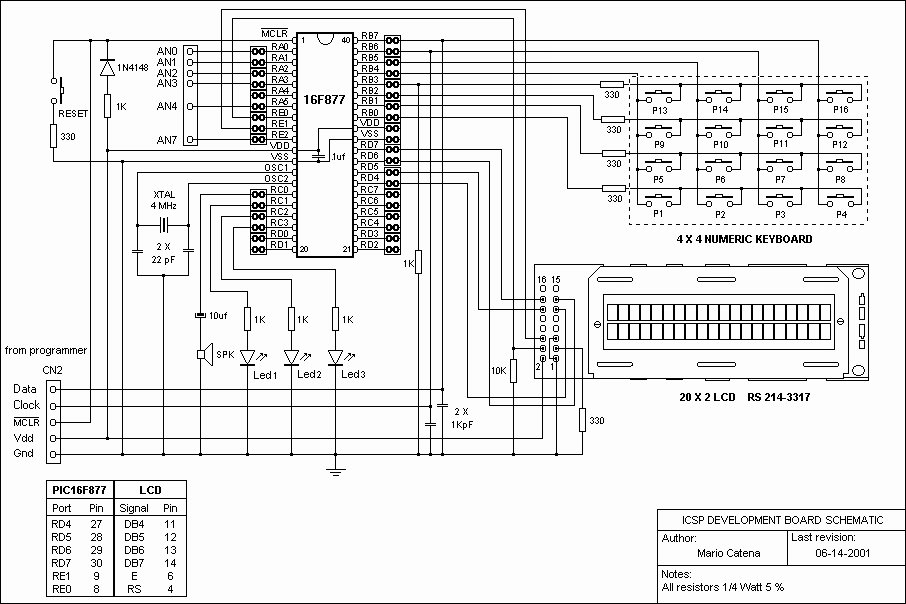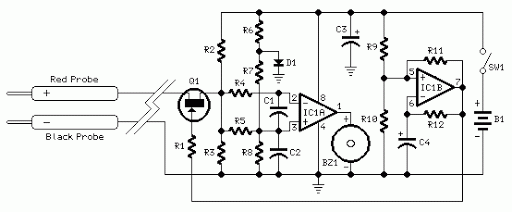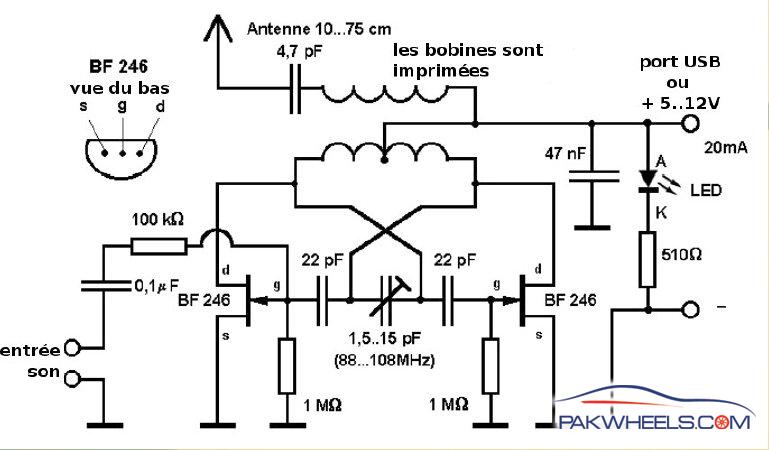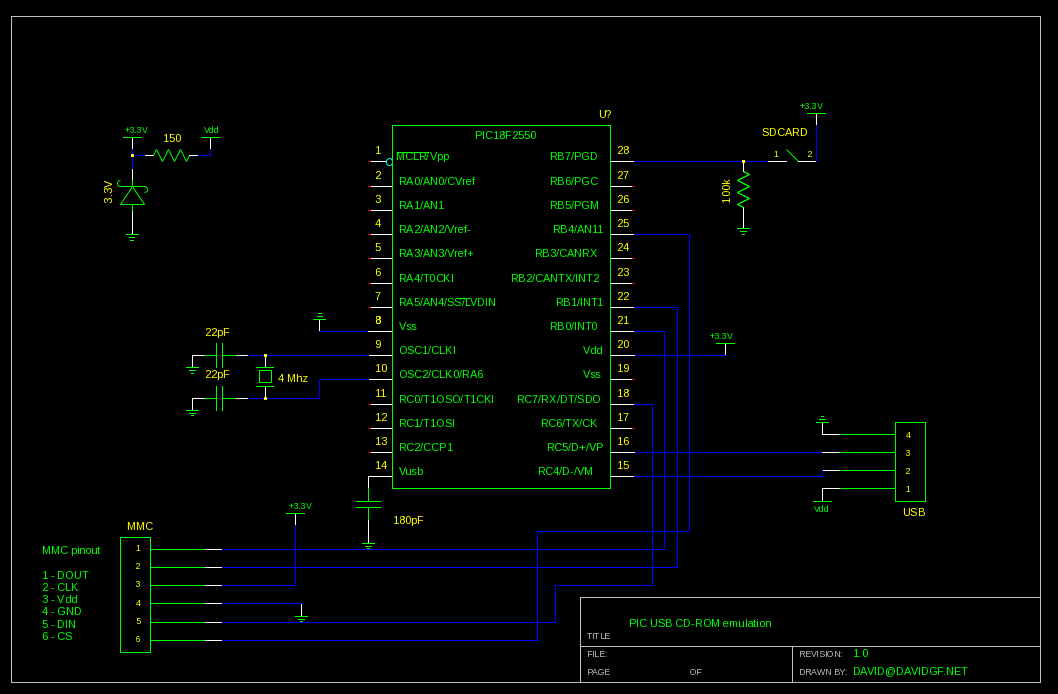
USB and GLCD Expansion Board for 8051SBC

The enable signal for the USB chip and GLCD controller is generated by a PLD decoder from the address lines. The memory map for the I/O of the 8051SBC board indicates that the available space ranges from 0x0300 to 0x07FF. The address range of 0x0300 to 0x03FF is allocated for the USB chip for both read and write operations, while the GLCD utilizes the range from 0x0400 to 0x04FF, with address lines A0-A3 used for selecting internal registers from 0x0404 to 0x040B. The use of a PLD as a memory decoder has been demonstrated in the 8051SBC. The schematic includes equivalent logic symbols for each enable signal. The logic equation shown in Figure 3, along with the corresponding logic circuit, illustrates the simplicity of the design. Figure 4 presents a sample layout created with universal PCB. The left connector, J4, is a 26-pin connector for the USB board, while the bottom connector, J3, is a 20-pin SIP connector for the GLCD board. The right connector, J2, is designated for the 8051SBC expansion header, and the upper part features a manual switch for turning the backlight on or off. Figure 3 also depicts the USB module produced by Astron Logic Company, which comes as part of an evaluation kit that includes the USB board, user manual, cable, and software CD for drivers and test software. This kit is available at a low cost directly from Astron Logic. The USB board is based on the FT245BM chip, which implements a complete hardware USB protocol conforming to USB 1.1 and USB 2.0 (full-speed mode). More information about the FT245BM can be found from Future Technology Devices International (FTDI). The graphic LCD is based on the Samsung KS1208 or Hitachi HD61202 controller, with internal registers mapped into external memory from 0x0404 to 0x040B. Access to these registers can be achieved using pointers with absolute addresses. The testing code is designed to display BMP files, although some functions can be modified for specific applications. Additional sample code and the GLCD datasheet can be obtained from the 128x64 graphic routines and tools for GLCD. When the TXE signal goes LOW, it indicates that the FIFO buffer is ready for data reception. The main code tests P3.3 with a 0x08 mask byte to check P3. If the result is low, the variable 'n' is written to the USB buffer via the pointer *usb_port. Instead of polling the TXE signal, the RXF signal is connected to the INT0 pin. When RXF is activated, it triggers interrupt EX0 for servicing. Data can be easily read using the pointer *usb_port, and the received data is displayed on the onboard text LCD. To test the setup with a host PC, the enclosed CD provides test software. By connecting the USB connector of the expansion board to a PC's USB port, the device can be selected. Upon opening the device, pressing S2 will send data to the PC, and the received window will display the bytes received (e.g., 0, 1, 2, 3, 4, 5, 6, etc.). For sending data, text can be typed in the "Send Immediate" window, and the corresponding ASCII letters will appear on the 8051SBC's LCD in real-time. The graphic LCD test code is currently under development and will be provided when available. A sample code for the GLCD is included, which prints three images sequentially with a delay.
The circuit described integrates a USB interface and a graphic LCD controller into the 8051SBC system, utilizing programmable logic devices (PLDs) for address decoding. The USB chip operates within a specified address range, allowing for efficient data transfer between the microcontroller and the USB interface. The schematic illustrates the connections between the 8051 microcontroller, the USB chip, and the GLCD controller, ensuring that the appropriate control signals are generated based on the address lines.
The PLD decoder simplifies the design by consolidating the glue logic required for enabling the various components. The use of a universal PCB layout allows for flexibility in the design and ease of manufacturing. Each connector is clearly defined, with J4 connecting to the USB board, J3 to the GLCD, and J2 providing an interface for expansion. The manual switch for the backlight enhances user control over the display.
The FT245BM USB chip provides a robust communication interface, supporting both USB 1.1 and USB 2.0 protocols, making it suitable for a wide range of applications. The graphic LCD, equipped with the KS1208 or HD61202 controller, facilitates rich visual output, with internal registers easily accessible through direct memory addressing.
The software component is integral to the functionality of the circuit, allowing for BMP file display and real-time data transmission to and from a connected PC. The interrupt-driven approach for data reception enhances responsiveness, while the ability to send ASCII data provides an interactive user experience. Overall, the circuit design effectively combines hardware and software elements to create a versatile and user-friendly system.The enable signal for USB chip and GLCD controller were made by PLD decoder from the address lines. As we have seen the memory map for i/o of 8051SBC board, the available space is from 0x0300-0x07FF. The address range of 0x0300-0x03FF was used for USB chip for both RD and WRITE operations. The GLCD used 0x0400-0x04FF with A0-A3 for selecting the i nternal registers from 0x0404-0x040B. We have learned from 8051SBC on how to use PLD as the memory decoder. In the schematic you may see the equivalent logic symbol for each enable signal. Let study the logic equation shown in Figure 3 and the equivalent logic circuit, you will understand how easy it is. Figure 4 shows the sample layout made by universal pcb. We see that with a PLD, the glue logic will be put together in PLD chip. The left-hand, J4 is 26-pin connector for USB board. And the bottom connector, J3 is 20-pin SIP connector for GLCD board. The right-hand connector J2 is for 8051SBC expansion header. Upper is manual switch for backlight turn on/off. Figure 3 shows the USB module made by Astron Logic Company. The evaluation kit consists of USB board, user manual, cable and software CD for driver and test software.
The kit is available at low-cost, to get it please contact Astron Logic directly. The USB board is based on FT245BM. The chip provides complete hardwire USB protocol that conforms USB1. 1 and USB 2. 0 (full speed mode). The FT245BM can learn more from Future Technology Devices International: FTDI. The graphic LCD is based on Samsung KS1208 or Hitachi HD61202 controller. The address of internal registers were mapped into external memory from 0x0404-0x040B. To access them we can use pointer with absolute address directly. The testing code is just display BMP file. However some function can be modified for the application purpose. More sample code and GLCD datahsheet can get from 128x64 Graphic routines and tools for GLDC. When TXE signal becomes LOW it indicates that the FIFO buffer is available for data to be received. In the main code it test P3. 3 with 0x08 MASK byte to AND with P3. If it low, the variable n will write to usb buffer through the pointer *usb_port. On receiving, instead of polling TXE signal, the RXF signal was tied to INT0 pin. When RXF actives, it will make interrupt ex0 to service. The data was read easily with pointer *usb_port. We can see the data shows on the on board text LCD. To test with host PC, the enclosed CD has test software. When we tie usb connector of the expansion board to a PC`s usb port. We can select device then. After open the device, when we press S2, it will send data to PC and the received window will show the byte being received, e. g. 0, 1, 2, 3, 4, 5, 6, . Also for sending, you can type text in Send immediate window, the ASCII letter will show on 8051SBC`s LCD while typing!
The graphic LCD test code is now under developing. I will put it when available soon. Below sample code for GLCD is just to print the three images with delay one by one. 🔗 External reference
The circuit described integrates a USB interface and a graphic LCD controller into the 8051SBC system, utilizing programmable logic devices (PLDs) for address decoding. The USB chip operates within a specified address range, allowing for efficient data transfer between the microcontroller and the USB interface. The schematic illustrates the connections between the 8051 microcontroller, the USB chip, and the GLCD controller, ensuring that the appropriate control signals are generated based on the address lines.
The PLD decoder simplifies the design by consolidating the glue logic required for enabling the various components. The use of a universal PCB layout allows for flexibility in the design and ease of manufacturing. Each connector is clearly defined, with J4 connecting to the USB board, J3 to the GLCD, and J2 providing an interface for expansion. The manual switch for the backlight enhances user control over the display.
The FT245BM USB chip provides a robust communication interface, supporting both USB 1.1 and USB 2.0 protocols, making it suitable for a wide range of applications. The graphic LCD, equipped with the KS1208 or HD61202 controller, facilitates rich visual output, with internal registers easily accessible through direct memory addressing.
The software component is integral to the functionality of the circuit, allowing for BMP file display and real-time data transmission to and from a connected PC. The interrupt-driven approach for data reception enhances responsiveness, while the ability to send ASCII data provides an interactive user experience. Overall, the circuit design effectively combines hardware and software elements to create a versatile and user-friendly system.The enable signal for USB chip and GLCD controller were made by PLD decoder from the address lines. As we have seen the memory map for i/o of 8051SBC board, the available space is from 0x0300-0x07FF. The address range of 0x0300-0x03FF was used for USB chip for both RD and WRITE operations. The GLCD used 0x0400-0x04FF with A0-A3 for selecting the i nternal registers from 0x0404-0x040B. We have learned from 8051SBC on how to use PLD as the memory decoder. In the schematic you may see the equivalent logic symbol for each enable signal. Let study the logic equation shown in Figure 3 and the equivalent logic circuit, you will understand how easy it is. Figure 4 shows the sample layout made by universal pcb. We see that with a PLD, the glue logic will be put together in PLD chip. The left-hand, J4 is 26-pin connector for USB board. And the bottom connector, J3 is 20-pin SIP connector for GLCD board. The right-hand connector J2 is for 8051SBC expansion header. Upper is manual switch for backlight turn on/off. Figure 3 shows the USB module made by Astron Logic Company. The evaluation kit consists of USB board, user manual, cable and software CD for driver and test software.
The kit is available at low-cost, to get it please contact Astron Logic directly. The USB board is based on FT245BM. The chip provides complete hardwire USB protocol that conforms USB1. 1 and USB 2. 0 (full speed mode). The FT245BM can learn more from Future Technology Devices International: FTDI. The graphic LCD is based on Samsung KS1208 or Hitachi HD61202 controller. The address of internal registers were mapped into external memory from 0x0404-0x040B. To access them we can use pointer with absolute address directly. The testing code is just display BMP file. However some function can be modified for the application purpose. More sample code and GLCD datahsheet can get from 128x64 Graphic routines and tools for GLDC. When TXE signal becomes LOW it indicates that the FIFO buffer is available for data to be received. In the main code it test P3. 3 with 0x08 MASK byte to AND with P3. If it low, the variable n will write to usb buffer through the pointer *usb_port. On receiving, instead of polling TXE signal, the RXF signal was tied to INT0 pin. When RXF actives, it will make interrupt ex0 to service. The data was read easily with pointer *usb_port. We can see the data shows on the on board text LCD. To test with host PC, the enclosed CD has test software. When we tie usb connector of the expansion board to a PC`s usb port. We can select device then. After open the device, when we press S2, it will send data to PC and the received window will show the byte being received, e. g. 0, 1, 2, 3, 4, 5, 6, . Also for sending, you can type text in Send immediate window, the ASCII letter will show on 8051SBC`s LCD while typing!
The graphic LCD test code is now under developing. I will put it when available soon. Below sample code for GLCD is just to print the three images with delay one by one. 🔗 External reference





